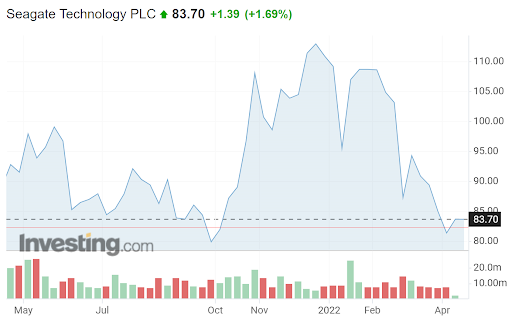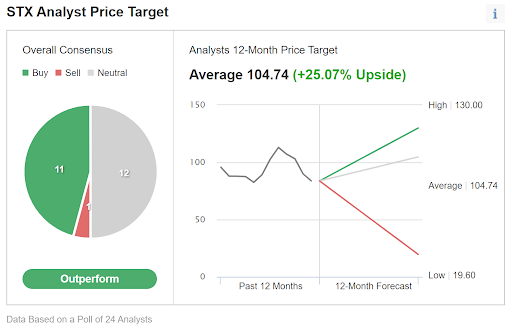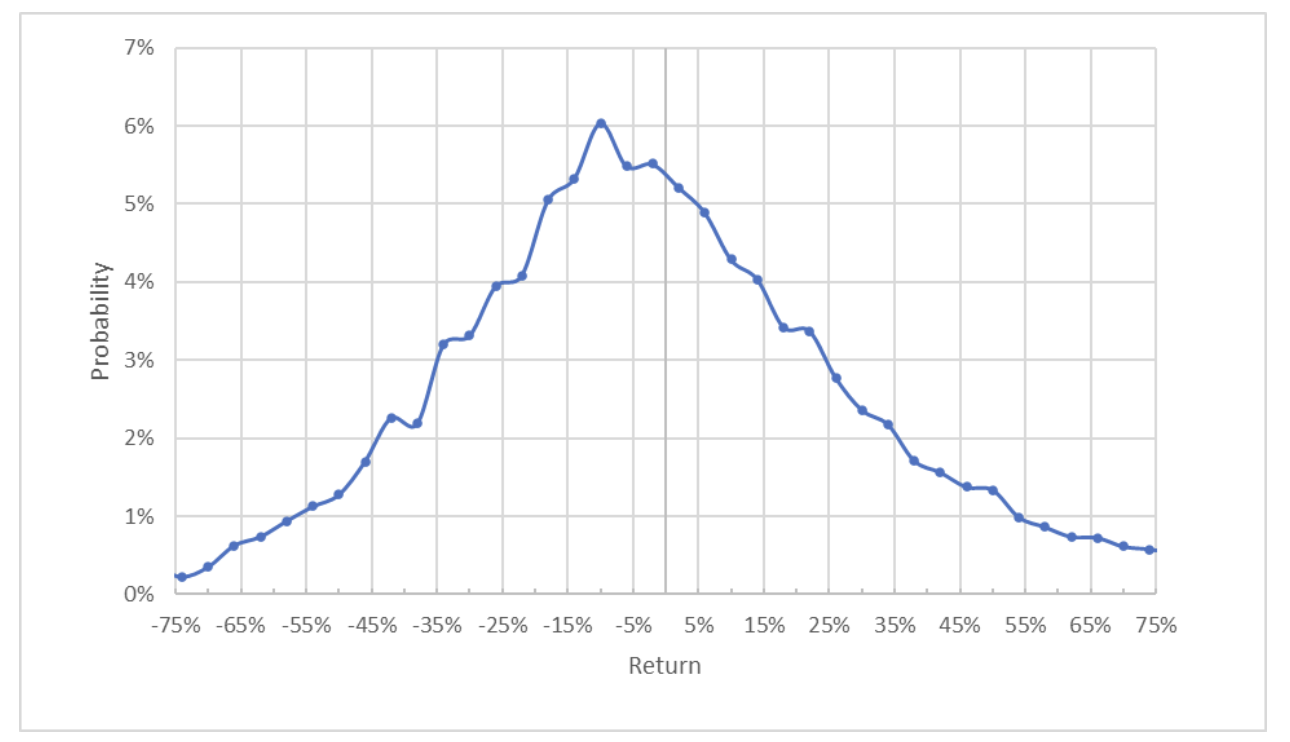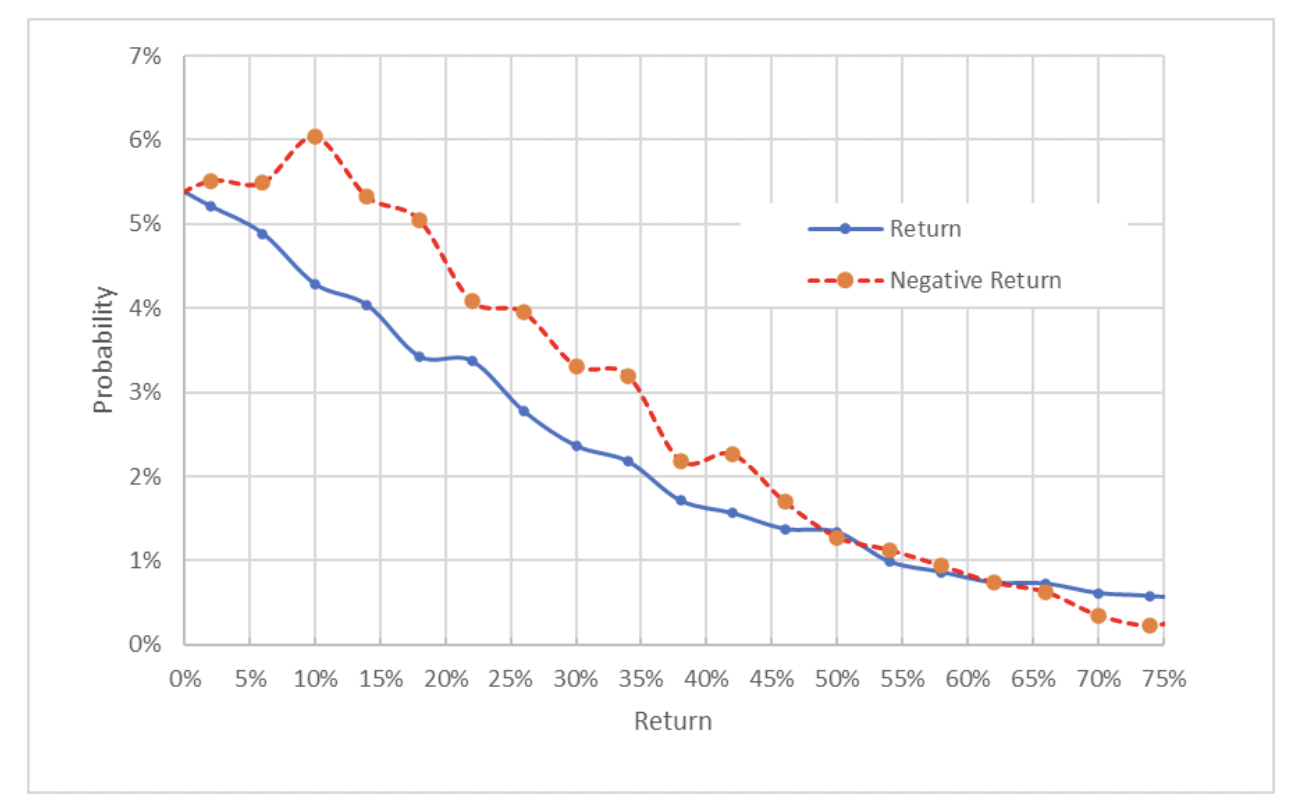- Seagate Technology is 28% off its 12-month high close
- The Wall Street consensus outlook is bullish, but there is a substantial spread in the price targets
- Market-implied outlook is moderately bearish into early 2023
- STX reports FY 2022 Q3 results on Apr. 27
Seagate Technology (NASDAQ:STX), a global leader in data storage technology and services, has returned a total of 3.6% over the past 12 months and -26.5% so far in 2022.
Even after this decline, the three-year annualized total return is 21.4%, as compared with 22.6% per year for the Invesco QQQ Trust (NASDAQ:QQQ) and 16.6% per year for the SPDR® S&P 500 (NYSE:SPY) over the same period.
Shares in the Irish-based mass storage solutions provider rallied 31% in the weeks following strong FY 2022 and Q1 results reported on Oct. 22, reaching a 12-month high closing price of $116.02 on Jan. 4. However, since then they have been on a downward trajectory, even though the company reported EPS that slightly exceeded expectations for FY 2022 Q2 on Jan. 26.

Source: Investing.com
Seagate is focusing on large-scale storage for future growth. Cloud technology stocks have faltered so far in 2022. The WisdomTree Cloud Computing Fund (NASDAQ:WCLD) is down 27% so far this year and STX has fallen in tandem. Susquehanna downgraded STX from ‘neutral’ to ‘negative’ on Apr. 14 based on a weaker outlook for cloud-related spending.
On Oct. 20, 2021, when the shares were trading at $81.32, I had a bullish rating on the stock. From that date until today, STX has returned a total of +5.3% vs. -1.3% for the SPY and -7.9% for the QQQ.
At that time, the Wall Street consensus rating for STX was bullish and the consensus 12-month price target was more than 20% above the share price. The valuation looked reasonable and the dividend yield was 3.3%.
I also based my rating on the predominantly neutral market-implied outlook.
The market implied outlook represents the consensus view among options traders as inferred from options prices. The price of an option on a stock reflects the market’s consensus estimate of the probability that the stock price will rise above (call option) or fall below (put option) a specific level (the option strike price) between now and when the option expires. By analyzing the prices of call and put options at a range of strike prices, all with the same expiration date, it is possible to calculate a probable price forecast that reconciles the options prices. For readers who want more background on this approach, I recommend this excellent monograph from the CFA Institute.
I have calculated an updated market-implied outlook for STX, spanning the period from now until January 2023, and compared this with the current Wall Street consensus outlook, in revisiting my rating.
Wall Street Consensus Outlook For STX
E-Trade calculates the Wall Street consensus by aggregating ratings and 12-month price targets from 18 ranked analysts who have published opinions over the past three months. The consensus rating is bullish and the consensus 12-month price target is $109.44, 30.7% above the current share price.
Back in October, the consensus price target was $100.40. There is substantial disagreement between the analysts, with the highest individual price target that is twice the lowest. This is a source of concern because high dispersion in price targets reduces confidence in the predictive value of the consensus. Research has shown that a high level of dispersion in the price targets corresponds to a negative correlation between the price return implied by the consensus and the subsequent performance. In other words, high dispersion and a high return implied by the consensus tend to be a bearish signal.

Source: E-Trade
Investing.com calculates the Wall Street consensus using ratings and 12-month price targets from 24 analysts. The consensus rating is bullish and the consensus 12-month price target is 25.1% above the current share price.

Source: Investing.com
While the Wall Street consensus rating is bullish, and the consensus price target implies a 12-month total return of 31% (the dividend yield is 3.4%), the high level of dispersion in the individual analyst price targets leads me to discount the predictive value of the consensus.
Market-Implied Outlook For STX
I have calculated the market-implied outlook for STX for the nine-month period from now until Jan. 20, 2023, using the prices of options that expire on this date. I selected this specific expiration date to provide a view through the end of 2022.
The standard presentation of the market-implied outlook is a probability distribution of price return, with probability on the vertical axis and return on the horizontal.

Source: Author’s calculations using options quotes from E-Trade
The market-implied outlook for STX to Jan. 20, 2023, is generally symmetric, but the peak probabilities are tilted to favor negative returns (a bearish signal). The maximum probability corresponds to a price return of -10%. The annualized volatility calculated from this distribution is 39%. This is fairly high volatility.
To make it easier to compare the probabilities of positive and negative returns, I rotate the negative return side of the distribution about the vertical axis (see chart below).

Source: Author’s calculations using options quotes from E-Trade
This view shows that the probabilities of negative returns are consistently higher than for positive returns of the same magnitude, across a wide range of the most probable outcomes (the dashed red line is above the solid blue line over the left two-thirds of the chart above).
Theory suggests that the market-implied outlook is expected to have a negative bias because risk-averse investors tend to pay more than fair value for downside protection (put options), although there is no way to determine if this bias is present. Even considering the potential for a negative bias, I interpret this market-implied outlook as moderately bearish.
Summary
Seagate has delivered six consecutive quarters of earnings that exceeded the consensus expected value. Its P/E of 10.3 is reasonable and it has a dividend yield of 3.4%. Despite that, the shares are 28% below the 12-month high close. The Wall Street consensus rating is bullish, with a 12-month price target that is 28% above the current share price.
However, there are concerns. First, the high dispersion in analyst price targets leads me to heavily discount the predictive value of the consensus. Second, the market-implied outlook is moderately bearish, as compared with a predominantly neutral outlook in October.
The market has substantially discounted cloud technology stocks since the start of 2022 and the market-implied outlook suggests that this downward pressure has a decent probability of persisting through the end of 2022, so I am reducing my overall rating on STX to neutral.
Which stock should you buy in your very next trade?
AI computing powers are changing the stock market. Investing.com's ProPicks AI includes 6 winning stock portfolios chosen by our advanced AI. In 2024 alone, ProPicks AI identified 2 stocks that surged over 150%, 4 additional stocks that leaped over 30%, and 3 more that climbed over 25%. Which stock will be the next to soar?
Unlock ProPicks AI